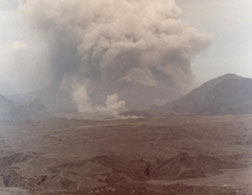|
  http://www.slate.com/id/2242931/ The Earth TrialsCan we test our geoengineering schemes before we have to use them?By Eli Kintisch Posted Thursday, Jan. 28, 2010, at 5:53 PM ET  Mount Pinatubo erupting in 1991The Copenhagen climate meeting was a big disappointment. Sen. Lindsey Graham now says the cap-and-trade bills "are going nowhere." So despite continued work toward cutting greenhouse emissions, we may see in the coming months a renewed interest in geoengineering—the deliberate, large-scale manipulation of the atmosphere—in an attempt to ward off the dangers of climate change. Mount Pinatubo erupting in 1991The Copenhagen climate meeting was a big disappointment. Sen. Lindsey Graham now says the cap-and-trade bills "are going nowhere." So despite continued work toward cutting greenhouse emissions, we may see in the coming months a renewed interest in geoengineering—the deliberate, large-scale manipulation of the atmosphere—in an attempt to ward off the dangers of climate change.
The once-rogue concept of planet-hacking has come a long way in just three years: from key private meetings among scientists, to sophisticated computer modeling papers (PDF), to serious investigations of the idea by the British Royal Society and the U.S. National Academy of Sciences. This week the discussion moves into a new phase: a debate over how actual field tests for geoengineering should be implemented, regulated and, in fact, whether their results would even help us to understand the most severe risks of deployment at all. In three opinion pieces published in the premiere science journals—one in Nature yesterday, and two in Science today—scientists from across the world offered differing takes on the future of internationally coordinated testing. But their back-and-forth over which experiments might be best and what sort of political treaties would be necessary raises a distressing possibility: It's not just that geoengineering tests will be difficult. It's that the problems they invite would be so diverse—and their results so inconclusive—that we're likely to skip the testing altogether. If countries are going to hack the stratosphere, they may just do it full-bore in the face of disaster. The three papers naturally focus on what's considered the fastest and most feasible form of geoengineering—the sun-blocking method some call the Pinatubo Option. If deployed, this would mimic the cooling effect of volcanoes by putting a cloud of particles in the upper atmosphere, where they could scatter a small percentage of the sun's rays. (It's named after the eruption of Mount Pinatubo in 1991. That event cooled the globe 1 degree Farenheit in less than a year by spewing 10 million tons of sulfur pollution into the stratosphere.) Scientists have proposed creating a cloud of sulfuric acid or other particles using airplanes, naval guns, or hoses suspended by balloons. So, can we do a practice run of the Pinatubo Option?
|

